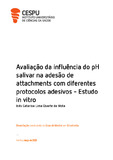Avaliação da influência do pH salivar na adesão de attachments com diferentes protocolos adesivos - Estudo in vitro

Mostra/
Data
2023Autore
Mota, Inês Catarina Lima Duarte da
Metadata
Mostra tutti i dati dell'itemAbstract
Introdução: Com o aumento das exigências estéticas, o recurso aos alinhadores invisíveis para a correção de más-oclusões tem sido cada vez mais frequente. Estes permitem a realização de movimentos dos mais simples aos mais complexos, no entanto necessitam de alguns auxiliares para esses movimentos serem mais eficientes, os attachments.
Objetivo: Este estudo tem como objetivo avaliar a influência do pH na capacidade de adesão de um adesivo multimode primer (ScotchBondTM Universal, 3MTM) e de um etch-and-rinse primer (Prime&Bond® NT, Densply Sirona) na adesão de attachments e comparar a capacidade de adesão dos diferentes protocolos aplicáveis (self-etch e etch-and-rinse).
Materiais e métodos: Foram utilizados 90 dentes bovinos: 30 como grupo de controlo (10 dentes com cada protocolo de adesão em meio seco), enquanto os restantes 60 dentes foram divididos e colocados em saliva artificial com pH 4 e pH 7, durante 7 dias a 37◦C, numa tentativa de simular o ambiente da cavidade oral. Foram aderidos 20 attachments com o protocolo etch-and-rinse com o adesivo Universal, 20 attachments com o protocolo etchand-rinse com o adesivo Prime&Bond NT e 20 attachments com o protocolo self-etch com o mesmo adesivo Universal previamente utilizado. Todos os attachments foram sujeitos à aplicação de uma força a velocidade constante, numa máquina de teste universal, até à perda de adesão. Resultados: Os attachments aderidos com os protocolos etch-and-rinse apresentaram maior adesão que os attachments aderidos com o protocolo selfetch (M=100.42, DP=47.49). Para além disso, o meio seco proporciona maior capacidade de adesão (M=209.27, DP=107.57) comparativamente aos meios com pH 4 e 7.
Conclusão: Os resultados sugerem que os adesivos utilizados com protocolo etch-and-rinse apresentam maior capacidade de adesão dos attachments, podendo haver alguma influência do pH do meio, no entanto a adesão não está dependente da interação entre eles (protocolo adesivo e pH) Introduction: With the increase in aesthetic demands, the use of clear aligners to correct malocclusions has become more and more common. These allow the execution of movements from the simplest to the most complex. However, they need some auxiliaries for these movements to be more efficient- the attachments.
Objective: This study aims to evaluate the influence of pH on the bonding strength of a multimode adhesive primer (ScotchBondTM Universal, 3MTM) and an etch-and-rinse primer (Prime&Bond® NT, Densply Sirona) in the bonding of attachments and to compare the bonding strength of the different applicable protocols (self-etch and etch-and-rinse).
Materials and Methods: 90 bovine teeth were used: 30 as control group (10 teeth with each adhesion protocol), while the remaining 60 teeth were placed in artificial saliva with pH 4 and pH 7, for 7 days at 37◦C, in an attempt to simulate the environment of the oral cavity. Ten attachments were bonded with the etch-and-rinse protocol with Universal adhesive, 10 attachments with the etch-and-rinse protocol with Prime&Bond NT adhesive and 10 attachments with the self-etch protocol with the same previously used Universal adhesive. All attachments were subjected to the application of a force at constant speed, in a universal testing machine, until adhesion was lost. Results: The attachments bonded with the etch-and-rinse protocols showed greater adhesion than the attachments bonded with the self-etch protocol (M=100.42, SD=47.49). Beyond that, the dry environment provides greater adhesion capacity (M=209.27, SD= 107.57) compared to the environment with pH 4 and 7.
Conclusion: The results suggest that the adhesives used with the etch-and-rinse protocol have a greater bonding strenght of the attachments, and there may be some influence of the pH of the environment, however the bonding is not dependent on the interaction between them (bonding protocol and pH).
